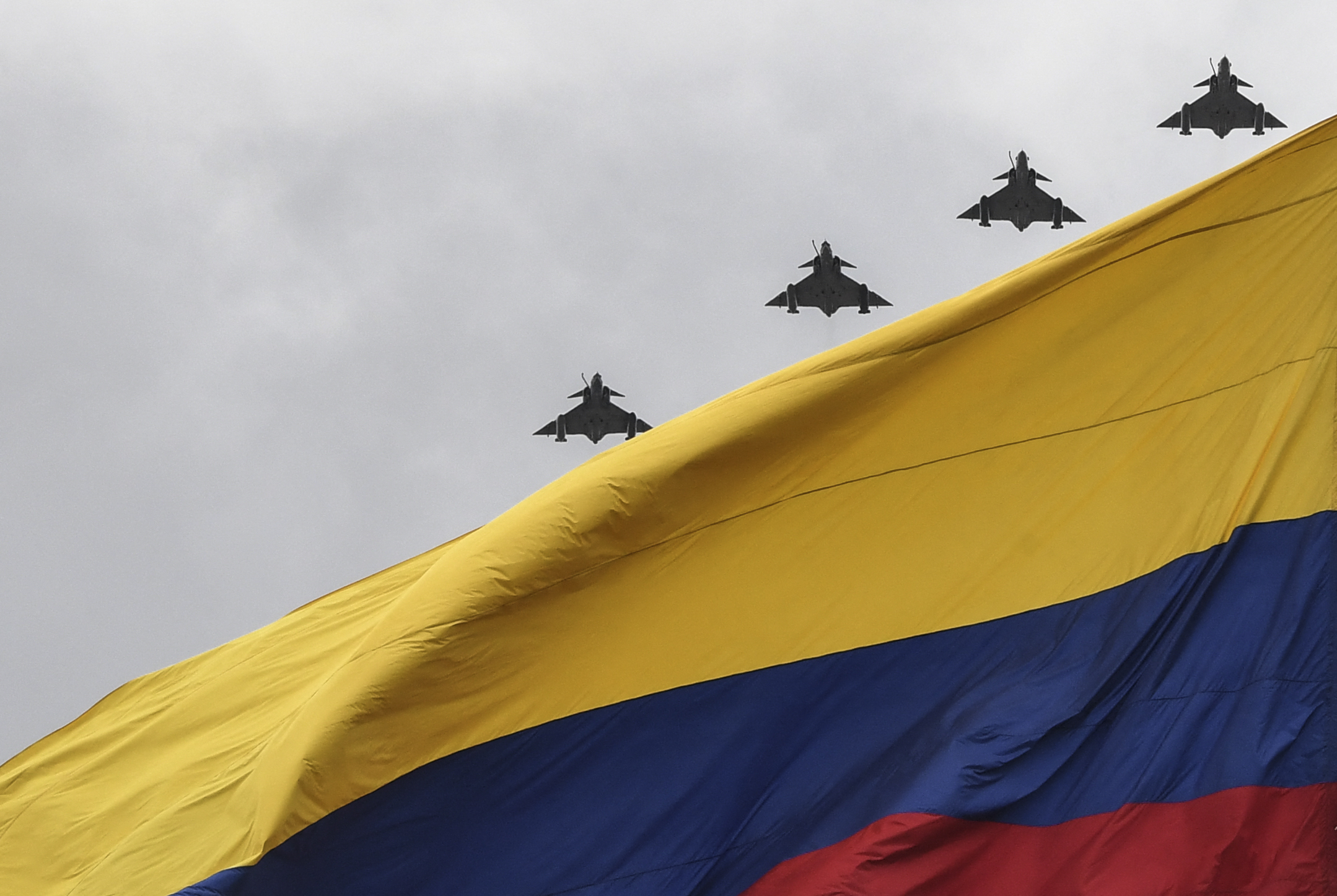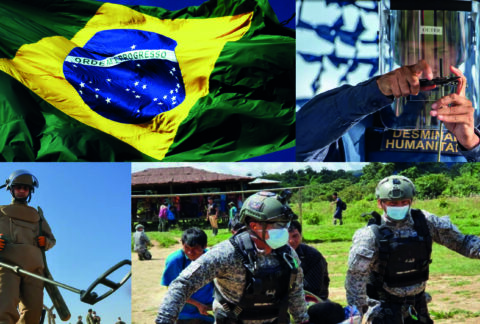Summary
This research is framed in the context of the acceptance of Colombia as “Partnership Across the Globe” by the NATO Council, which represents the ninth global partner of NATO and the only country in America to achieve such a relevant status. However, beyond this significant event, little is openly known about the agreement and what progress has been made to date. For this reason, this research seeks to address these concerns and provide valuable information on the progress, commitments and opportunities for the Armed Forces within the framework of this important alliance. For the development of this research, a qualitative methodological approach was implemented, using tools for the analysis and triangulation of information, which included contributions from expert personnel and data from specialized sources on the subject.
Subsequently, the research focuses on the opportunities of the Colombian Air Force within the framework of the agreement, considering the distinctive capabilities of the Colombian Air Force and its deterrent potential, through an analysis structured in the DOMPI model that contrasts the weaknesses, opportunities, strengths and threats of the Colombian Air Force; in order to propose a strategic guideline that potentiates air power through deterrence.
Keywords: Distinctive Capabilities; Colombian Air Force; Deterrence; NATO; Global Partner.
Introduction
This research article makes significant contributions to the line of research on strategy, geopolitics and hemispheric security, as it addresses the issue of the political and military agreement between Colombia and NATO (North Atlantic Treaty Organization), which stands out as one of the most important organizations in the world, for its presence and global influence on issues associated with security and defense; therefore it is a developing issue of great interest to the political and military sector.
As the main background, on May 18, 2017, Colombia was accepted as the ninth global partner of NATO, becoming the only country in the Americas to achieve that status; subsequently, the agreement was formalized by DR. Juan Manuel Santos (President of Colombia at that time), during his visit to Belgium on May 31, 2018. However, the information available on the opportunities, scope and current status of the development of the agreement are not openly known, which generates uncertainty about the degree of interaction between Colombia and NATO as a partner and non-member.
Thus, to understand the scope of the agreement, the research initially analyzed the general context, in order to understand the characteristics and strategic approach of NATO, delving into concepts relevant to the research such as the element of deterrence; in order to understand the potential opportunity implied by the agreement to strengthen the capabilities of the Armed Forces, improving quality standards, reinforcing their preparation to face current and emerging threats, ensuring the protection of national sovereignty. This scope is reaffirmed in the Defense and Security Policy (PDS – 2019):
Diplomacy, within the framework of cooperative security, will be the main means Colombia will employ to guarantee its defense and security in the face of external threats. At the same time, sufficient military capabilities and the decision to use them to deter, individually or collectively, any aggression that a State or group of States might intend to carry out against the country will be developed and maintained. Deterrence and international security will also be the main objectives of Colombia’s alliances (Ministerio de Defensa Nacional, 2019, p. 48).
It should be noted that the information resulting from the research on the status of the agreement between Colombia and NATO is of general relevance for the Armed Forces; however, the objective of the research is framed in the Colombian Air Force for which the following research question was posed: Do the distinctive capabilities of the FAC enhance Colombia’s military deterrence in the framework of cooperation with NATO? For its development, the general objective was taken into account: To analyze the distinctive capabilities of the FAC as an element of deterrence in the framework of cooperation with NATO. Thus, three specific objectives were proposed for its fulfillment:
- To identify the current deterrence capabilities of the Colombian Air Force.
- To establish the characteristics of the alliance between Colombia and NATO.
- To identify the challenges and scope of the Colombian Air Force in the framework of cooperation with NATO.
And finally, an objective was proposed to contribute to the strategic planning of the FAC:
4.Propose strategic guidelines that potentiate the deterrence power of the Colombian Air Force in the framework of cooperation with NATO.
During the development of the research there were significant limitations, such as the scarce information available in open sources about the commitments, challenges and scope of the agreement, as well as information on the status of its implementation. Likewise, the objectives of the research demanded updated information, since recently both NATO and FAC had significant changes in their organization, causing the documentation published from academic sources to be inaccurate in this aspect, which implied searching for recent information that was difficult to access, available only through agencies specialized in the subject.
For the development of the research, a qualitative methodological approach was proposed, taking into account that this approach allows the generation of theory based on the characteristics and complexity of the phenomena to be studied. The population under study was selected for its experience, profile and positions held, among which are FAC Commander, Chief of Combat and Airspace Defense, Potential Combat Director, Combat Group Commander and Commander of the Weapons and Tactics Center, which supports the expertise of personnel in leadership in the conduct of Air Force Air Operations, ensuring valuable contributions that contributed significantly to the research. Additionally, information was researched through specialized agencies, such as the Colombian Foreign Ministry, reports from the Belgian Attaché Office and the International Affairs Office of the FAC, in addition to documentation, current legislation and theoretical support obtained from recognized academic sources. The information investigated was categorized with the ATLAS.ti tool and triangulated for its analysis, providing a solution to the objectives proposed for the development of the research.
Thus, the analysis of the DOMPI model was consolidated, discriminating the weaknesses, opportunities, strengths and threats of the Colombian Air Force within the framework of the agreement with NATO, and with this, the final objective of proposing a strategic guideline for the Colombian Air Force, oriented to potentiate air power through deterrence.
Frame of reference
Conceptual framework
North Atlantic Treaty Organization (NATO), a political and military alliance.
In order to understand aspects of the research, it is necessary, in the first place, to conceptualize and explain the origin of NATO (North Atlantic Treaty Organization), which is an organization created through the signing of a treaty in the city of Washington on April 4, 1949, with the objective of maintaining the security of the countries belonging to Western Europe in the face of the Soviet Union and its allies. Thus, it is important to highlight that NATO materialized the foreign policy proposal implemented by the United States in the face of the Soviet Union, where the strategy sought to contain the communist threat. After 1991, NATO’s objective was reformulated in order to maintain security in the northern hemisphere (Lara & Jimenez, 2019).
In order to contextualize its scope and geographic impact, the member and partner countries are enunciated below, illustrating their location:
Member States (30):

Allied or partner countries from around the world (09):

Other partnership mechanisms with NATO: Partnership for Peace (PFP – 20 states), Mediterranean Dialogue States (MD – 07 states) and Istanbul Cooperation Initiative (ICI – 04 states).
Figure 1
Location of current NATO members
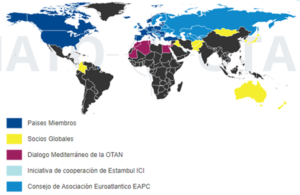
Historically, the following NATO milestones are highlighted:
Table 1
NATO milestones since its foundation

Consequently, this background allows us to glimpse and understand the opportunity of Colombia’s participation in the cooperation, since since 1948 after the assassination of Jorge Eliécer Gaitán, the liberals and conservatives decided to align themselves with the American discourse against communism, being faithful to their doctrine in terms of foreign policy, called “recipem poloum”. Since then, in the Cold War period, this alignment was a constant that directly influenced Colombia’s internal affairs, leading to the fact that, in 2013 Colombia started rapprochements with NATO, with the beginning of the construction of the information security agreement, subscribed and signed by the then Minister of National Defense, Juan Carlos Pinzón Bueno, in Brussels, Belgium.
According to Lara & Jiménez (2019), it is pertinent to analyze the strategic progress that occurred in Colombia and NATO, after their consolidation as actors. Taking into account that NATO promotes and defends democratic values and the peaceful resolution of conflicts in the first instance, it facilitates its understanding, to state the strategic concepts that NATO has historically established, as follows:
Table 2
Evolution of NATO’s strategic concepts
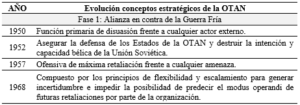
Thus, NATO’s pillars are collective defense, crisis management and cooperative security.
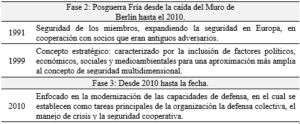
As for the Colombian strategy, it has been influenced by the Spanish doctrine, French doctrine, Prussian doctrine, American doctrine, Insurgent I and II doctrine. Highlighting recently in 2016 the institution of the doctrine of unified land operations (OTU), applied in the JLA as Damascus, with which a step is taken to offer the military capabilities of Colombia to the world and achieve the interoperability of the FF.MM with NATO Lara & Jimenez (2019).
Deterrence, an additional strategy to Air Power
Deterrence has been an important element for the formulation of the foreign policy of States in the contemporary international system. It involves a vital aspect linked to the exercise of power and its capacity to influence the conduct of other national and international actors.
A first approach to the concept of deterrence can be based on the definition given by the Royal Academy of the Spanish Language (2020), where it is understood as: “to induce or move someone to change his mind or desist from a purpose”. This definition reflects the primary intention of the deterrence strategies, and in turn, the counterposition of interests, counterpart.
Continuing with the general approach to deterrence, Wiggins (2019), highlights that there are two categories of deterrence, specific or simple and general. Both categories involve the idea of a threat that can influence individuals not to commit crimes. On the one hand, specific deterrence focuses on the individual and is based on the assumption that, if the punishment imposed on an offender is severe enough, the offender will not commit crimes in the future. General deterrence, on the other hand, focuses on society and is based on the idea that potential offenders will be deterred by the fear of being punished. It should be noted that, in both categories, deterrence is based on the assumption that potential offenders are rational and will perceive the possible punishment for a crime.
The conceptual and theoretical construction of deterrence in the field of international relations, especially in the area of politics and security, According to Morgan, cited by Palazón, (2018) has focused on the prevention of an imminent military attack and on estimates of the opponent’s war capacity. Deterrence acquired a strategic character with the advance of nuclear weapons, especially, in the cold war significantly influencing the formulation of the foreign policy of the United States and the Soviet Union, being a differentiating aspect in the formulation of national security policy and in turn, closely related to the implementation of international policy.
Sodupe (1991) argues that deterrence occurs in an anarchic international system and serves as a justification for the conflictive nature of international policy, in line with the realist paradigm. In addition, it becomes the propitious scenario for States to exercise their power freely and influence the behavior of other States to the benefit of their national interests. Thus, it should be noted that deterrence theory emerged as a response to Washington’s strategic concerns. With the firm intention of advising U.S. political leaders on how to implement the idea of deterrence and what kinds of forces could most effectively facilitate deterrence.
In this sense, deterrence from a traditional approach has an eminently political character that seeks to safeguard the vital national interests on which a state bases its survival. This is the level at which all actions can be combined and strategies can be coordinated to guarantee its interests and vital space. Additionally, Isidoro (2006) indicates that the military strategic sphere is where deterrence is actually executed and exerts its determining effect by questioning the use of available means and resources by potential adversaries or by initiating specific hostile actions.[3] Today, a proposal has been put forward for a new approach to military deterrence.
Today, an innovative proposal is presented considering deterrence as an independent variable, which exponentially potentiates everything referred to Air Power, allowing the Deterrence Strategy to be applied as a State Policy, providing a power tool for the defense and security of the country (Barrero, et al., 2020).
In the work Comprehensive Air Power of the Nation State in the 21st Century, the new vision of Air Power is proposed from an integral conception, expressed in the following equation, where deterrence is visualized as an exponential variable (Barrero, et al., 2020): PA = [(VP + E ) * ( (O + D) + (M * T )) ] d
The variables expressed correspond to: (VP) political will, (E) economy, (O) organization, (D) doctrine, (M) air assets and (T) technology.
Thus, it is very relevant to identify the deterrent capabilities that meet the expectations of National Security, since Air Power results from these (Barrero, 2020).
Research Methodology
Methodological approach
The research is proposed with a qualitative methodological approach, taking into account that this approach allows the generation of theory based on the characteristics and complexity of the phenomena to be studied.
Exploratory Scope
Taking into account that there are few studies conducted that allow understanding the distinctive capabilities of the FAC as a deterrent element in the framework of cooperation with NATO, it is considered that it is a little studied topic, given that Law 1839 of 2017 that proposed the participation in activities as a global partner of NATO, is a recent agreement and is currently still in the process of implementation; since in the first instance the security certification, the possession of the military representative and the beginning of the interoperability process are pending.
Study population and unit of analysis
The study population was constituted by expert officers in the leadership and development of Air Operations, who have held the following positions: FAC Commander, Chief of Combat and Airspace Defense, Potential Combat Director, Combat Group Commander and Commander of the Weapons and Tactics Center. They have knowledge and experience on the distinctive capabilities of the Colombian Air Force, which will be considered for the NATO certification process, allowing with their contributions the fulfillment of the objectives proposed in the research.
On the other hand, the Colombia – NATO agreement and its current status were considered as a unit of analysis, based on the information researched through the Colombian Foreign Ministry, the Belgian Attaché Office, the International Affairs Office of the FAC and other legislation and documentation in force in this regard.
Techniques and instruments
The non-probabilistic snowball technique was used, which, according to Martín-crespo & Salamanca (2007), allows finding and selecting the participants who meet the desired characteristics for the fulfillment of the objectives.
The information collection instrument consisted of a semi-structured interview that allowed firstly, to identify the current deterrence capabilities of the Colombian Air Force, secondly, to establish the characteristics of the alliance between Colombia and NATO and finally, to identify the challenges and scope of the Colombian Air Force in the framework of cooperation with NATO.
The bank of questions for the interview was elaborated from the triple entry table, which as described by Ramirez (2007) is a methodological tool that allows the elaboration of questions based on categories and subcategories directly related to the specific objectives. Thus, the interview consisted of 14 questions based on the following categories: FAC Capabilities, NATO Agreement, FAC Challenges and Reaches, and Deterrence; and the following subcategories: FAC Units, FAC Doctrine, FAC Organization, FAC Materials, FAC Personnel, FAC Infrastructure, FAC Strengths, Current NATO Projects, and Weapons and Tactics Center Functions and Tasks.
The analysis of the information was done with the help of the qualitative analysis software ATLAS.ti, version 8.3.1, which issues a report discriminating the information provided by the experts, based on the categories and subcategories exposed above. It should be noted that the software issues codes (example: 1:7), which reference the information anonymously, thus guaranteeing ethical aspects of the research, such as the confidentiality of the participants. The analysis and discussion of results was elaborated based on the triangulation of information, as described by Mayumi (2005), a tool that offers rigor, validity and quality to qualitative research, in accordance with which the information provided in the ATLAS.ti report, the specific objectives and theoretical and conceptual aspects of importance for the research were triangulated.
Analysis and discussion of results
Current deterrence capabilities of the Colombian Air Force.
Once the requirements that NATO demands to be global partners have been fulfilled, which are to have a democratic system, a stable government, legitimate armed forces, policies of respect for human rights, democratic values and acceptance of NAC (North Atlantic Council), the distinctive capabilities must be defined to continue with the process to achieve interoperability with NATO, which is the desired end state.
For this reason, it is imperative to know the distinctive capabilities of the Colombian Air Force and discriminate those that can be significantly strengthened through the agreement with NATO. Therefore, in the first place, the concept of “distinctive capabilities” is exposed, which is defined by the Colombian Air Force in the Basic Air, Space and Cyberspace Doctrine Manual 2020 edition, as the set of activities that the FAC best performs by virtue of the elements that make up the Air, Space and Cyberspace Power and lists the following:
- Airspace control.
- Immediate and decisive response to internal and external threat aggression.
- Conduct of strategic air operations.
- Conduct of air defense operations.
- Exploitation of information and situational awareness.
- Conducting close air support operations.
- Combat and military air transport, as well as transport of the President of the Republic and the Presidential Family.
- Training of Public Force aircrews.
- Personnel recovery.
- Effective reaction to national emergencies or natural disasters.
- Support to the economic and social development of the country.
- Commitment to the control and protection of the environment.
- Management of air navigation services of the Public Force.
- State aviation aeronautical authority.
- Aeronautical research and development.
- Regional interoperability with international projection.
- Ensuring cyberspace superiority in air and space operations.
- Multiply air and space power using cyberspace as a means to support and alternate courses of action in other domains.
- Access and exploitation of outer space.
- Conducting space operations.
Taking into account these capabilities, it is worth mentioning that the operational experience in combat in all the Squadrons plays an important role as a real deterrence element, as well as the sum of different factors such as: training, standardization, combat morale, institutional organization, technology, adequate command and control, strategic alliances with powerful Air Forces to train in a combined and standardized manner, as well as the agreement signed with NATO. This is not to say that better capabilities are not required to balance this balance of potentials (1:3).
As for the distinctive capabilities of the FAC, those of deterrent strength are the ones that allow showing an effective control of the airspace, for which an integrated air defense system must be in place, which contemplates the joint capabilities of the FFMM. On the other hand, the training and experience of the aircrews, together with an excellent equipment and personnel readiness, are an additional source of the deterrence to be shown (3:2). Within these capabilities, the Air Counter Power, Strategic Strike and Air Refueling missions stand out, and in terms of operation, Interdiction and Close Air Support stand out (4:1).
In terms of operational experience, the FAC has the following strengths in the application of capabilities, which in turn contributes favorably to deterrence (5:2): Air superiority squadron, with international recognition; extended global reach[4]; actual experience in strategic strike missions; training and training: based on the air doctrine received by the USAF (United States Air Force) to Combat Squadron No.111 KFIR for international air combat exercises (Red Flag 2012, 2018); successful participation in operational air combat exercises in the world such as: RED FLAG, CRUZEX, MAPLE FLAG, GREEN FLAG, among others; doctrinal formation and professional training in FAC crews[5]; capabilities in electronic warfare; in-flight refueling; air transport; aeromedical evacuations, NVG operation capacity and cooperation activities with other countries in defense (1:13).
In this sense, it is imperative to keep in mind that deterrence is an essential concept for the security and defense of the nation. Therefore, it must be credible, measurable in terms of real power (1:1). Thus, National Power, understood as the capacity and will of a State to defend its national interests, through deterrence can send a clear message to internal and external threats, that it is effectively prepared to respond, confront and defeat them if necessary; taking into account that, if the balance of potentials is unfavorably inclined towards the one who wants to generate Deterrence, Strategic Alliances play a very important role (1:2).
Thus, the priority of determining the potential risks to our national security and defense arises, being required to have a prepared FFMM in the event that deterrence is not sufficient to prevent warlike action by the enemy; for this reason it is important at all times to adopt the necessary measures to achieve a credible deterrence and prevent an external or internal adversary from attempting to jeopardize the vital interests of the nation. For this reason, it is of vital importance to keep distinctive capabilities strengthened and updated, in order to show a credible capability ready to face any threat and thus influence the adversary to desist from its pretensions or threats (3:1).
In this context, the agreement with NATO should be conceived as an opportunity to enhance the distinctive capabilities of the FAC, taking into account that being global partners is a privileged position shared with only eight other countries and unique in Latin America, so there must be a strategy with guidelines that allow the Air Force to begin to exploit this alliance that opens the doors to interact with member countries, where it can potentially strengthen current capabilities.
At the same time, the agreement allows strengthening the expansion of the concept of security with the global reality, covering regional security as a model of the globalized world, which is characterized by its cross-border condition that allows it to expand between different States, and although NATO is not precisely in the region close to Colombia, it allows a global projection, which through the exchange of knowledge can improve and acquire capabilities that prepare it to face the threats of the new scenarios, such as those of cyberspace.
Characteristics of the alliance between Colombia and NATO
The alliance with NATO is characterized as “a functional, flexible and mutually reinforcing alliance that recognizes and builds on NATO’s strategic concept and Colombia’s national interests” (ICPC, 2019, p. 3).
In order to delve into the details of this important alliance, the current status of the agreement between Colombia and NATO is investigated, reviewing the progress and fulfillment of the commitments and tasks established between Colombia and NATO until July 2020, for which a documentary review of the information provided by the experts interviewed in collaboration with the Military Defense Attaché Office Kingdom of Belgium and before NATO (1:7), published documents referring to the subject and based on the information provided by the Office of International Affairs of the FAC:
Current status of the cooperation agreement
By becoming a “Partnership Across the Globe” of NATO, Colombia allows it to interact with the most important political-military organization in the world, being the first Latin American country to be accepted as a NATO partner, which in turn allows it to show its capabilities and experiences in the military field and, likewise, to receive all the contributions in training and interoperability from the organization.
Strategic achievements
- Security Agreement: Signing of the security agreement on June 25, 2013 by MDN JUAN CARLOS PINZÓN.
- Acceptance: Colombia is accepted as a partnership across the globe in May 2017 and the IPCP is signed on May 18, 2017.
- Presidential visits: Between May and October 2018, presidential visits to NATO and meeting with the Secretary General took place to strengthen the agreement, where the certification of the country’s demining capabilities was highlighted to share the experience with other allied nations, the issue of cybersecurity was addressed and it was agreed to accelerate cooperation for the prevention of cyber-attacks.
- CIDES (International Demining Center): On March 19, 2019, the acceptance of CIDES as part of the PTEC (Partnership training and education center) was received.
- Mission acceptance: From Colombia to NATO on April 7, 2019.
- Closing process: Security agreement in April 2019 and NATO was informed.
- IPCP: Endorsement on May 18, 2019 of the IPCP, which is valid for two years (2021). This is the document of the “Individual Partnership and Cooperation Program between NATO and the Republic of Colombia, which highlights the following principles, challenges and shared commitments: Common democratic values, international security and stability based on the rule of law. Respect for Human Rights, International Humanitarian Law and fundamental freedoms. Challenges in matters related to international security. Terrorism and its connection with transnational organized crime, corruption and drug trafficking are growing and continuous threats to democratic societies, representing a challenge for States.
Colombia is a reference in the implementation of international cooperation strategies in the fight against transnational organized crime and participates in different peacekeeping missions and operations.
Despite the geographical distance, Colombia and NATO have progressively developed cooperation in different areas: military education and training, maritime security, integrity and good governance, with the purpose of increasing interoperability and connectivity, building capabilities and sharing best practices.
Strategic objectives, basis for cooperation (ICPC, 2019, p.3):
Strengthen connectivity by promoting political and practical interaction, with the vision of developing common approaches to global security challenges such as cyber security, maritime security, terrorism and its links to transnational organized crime.
To develop common approaches to address security challenges, oriented to high standards and best practices, supporting peace and security efforts, including human security.
Strengthen the professionalism of the Colombian Armed Forces and interoperability with NATO forces while building skills and capabilities.
Priority areas for dialogue, consultation and cooperation (ICPC, 2019, pp. 3-5):
- Hold political consultations in areas of security that are of interest to both and thus strengthen peace and security.
- Cover reciprocal security standards in the protection of information to be exchanged (facilitate information and intelligence sharing).
- Improve the interoperability of NATO and the Colombian Armed Forces through training, education and military exercises, pursuing military operational, doctrinal and educational standards, as well as support the transformation of the Colombian Armed Forces, including the adoption of NATO standards, as well as life cycle management and codification of best practices, as appropriate.
- Enable Colombia’s defense and related sectors to continue implementing integrity and good governance reforms to achieve and maintain best practices worldwide by continuing to build defense cooperation capabilities focused on areas such as logistics support and organizational development, with a long-term sustainment perspective.
- Establish scientific and technological cooperation channels with the NATO Science and Technology Organization.
- Improve Colombia’s cyber-defense capabilities, in particular by exploring activities in the fields of information sharing, education, training and exercises.
- Improve Colombia’s Crisis Management capabilities through information, training and exchange of lessons learned with NATO.
- Build on previous cooperation in the context of counter-piracy, exploring new opportunities for interaction in the maritime domain, with the intention of strengthening naval interoperability.
- Expand and strengthen demining cooperation, notably through the participation of the Colombian International Demining Center (CIDES).
- Explore Colombia’s capabilities to support NATO efforts and operations, as relevant in areas such as humanitarian demining, counter Improvised Explosive Devices (IEDs), counter-narcotics, Special Forces and asymmetric warfare.
- Develop cooperative activities with the Science for Peace and Security Program, with a particular emphasis on projects related to Women, Peace and Security; science and technology; and counter-IEDs and demining.
- Develop cooperation in public diplomacy to promote mutual understanding and transparency.
- This information describes the areas of cooperation between Colombia and NATO, considering the NATO Interoperability Initiative endorsed at the NATO Wales Summit, which should be taken into account by the Armed Forces to define and prioritize the distinctive capabilities that will be strengthened through the agreement, including a vision of possible contributions to NATO operations.
Objectives to be achieved by 2020 and completion status as of July:
Table 3
Progress on NATO agreement objectives
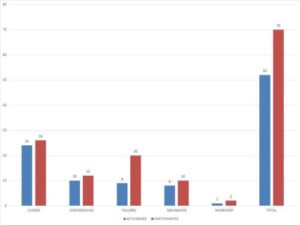
Processes moving forward (1:6):
Force interoperability project with NATO: These processes are being developed under the project methodology for the planning and management of all project components as follows:
Doctrine: Study and selection of doctrine standards to be applied in the Force.
Organization: MILREP acceptance process before NATO, and possibility of extending the mission before NATO HQ. Organization in the CGFM General Staff of the NATO Liaison office.
Training: PTEC-CIDES accreditation, accreditation of CIDES courses, fulfillment of academic offerings in 2020 and approval of academic offerings in 2021.
Standardization: Development of the process to standardize the English program in the Force. “OCC (Operational Capability Concept) processes.
Selection and management: NATO courses for the participation of the Colombian Forces according to the needs of the Forces.
The above, based on the individual cooperation program protocolized by the President in October 2018, which was endorsed in May 2019 by the North Atlantic Council.
Activities carried out during 2019:
Figure 2
Academic events programmed by NATO and Colombian participation.
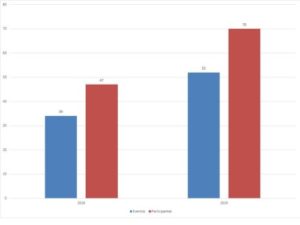
Figure 3
Comparative statistics of academic offerings 2018 – 2019:
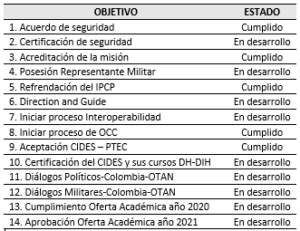
An increase of 65% of events scheduled in 2019 with respect to the previous year is observed, which demonstrates the strengthening of the Educational Offering within the agreement with NATO.
Figure 4
Provenance of the 70 participants of the 2019 academic offer:
Opportunities and Engagements:
Table 4
Opportunities and commitments arising from the agreement with NATO.

Interoperability process:
Figure 5
Process for achieving interoperability with NATO
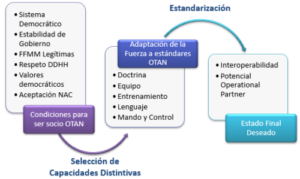
Once the conditions and requirements for NATO membership have been met, the adaptation of the Colombian Air Force to NATO standards is underway, a process that involves the certification procedure of distinctive capabilities, through the “Operational Capability Concept Evaluation and Feedback Programme” (OCC E&F), which will be detailed below, in order to achieve interoperability with NATO.
Challenges and scope of the Colombian Air Force in the framework of cooperation with NATO
In a changing world, where traditional theories fall short, since they only contemplated the State as the only international actor, it is necessary to evolve the security doctrine for the States in order to face the dissimilar threats in the new transnational, inter-State and intra-State problems. In Latin America, Transnational Organized Crime threats predominate (drug trafficking, arms trafficking, cybercrime, among others), where the concept of Multidimensional Security is appropriate for the renewal of security, so it is expected that the exchange of knowledge with NATO will strengthen the capabilities to face the emerging threats of globalization. This, at the same time, strengthens the level of national deterrence in the region.
Therefore, it is timely to have cooperation at these levels in accordance with what was stated by Alvarez et al (2017) “States in the International System are to some extent immersed in a global network of interdependence on security issues. However, because insecurity is often associated with proximity, this interdependence would be far from uniform.”
In the same sense, according to NATO (2006), interoperability is related to the development of capabilities for joint operations between military units of different nationalities and armed services (land, naval and air forces). For this reason, developing these capabilities implies an investment in resources, which would stimulate several production sectors and would encourage technological development, thus providing space for innovation. Likewise, interoperability between military forces makes it possible for States to strengthen globalization processes. The interoperability process also has an impact on the implementation of best practices that contribute to operational efficiency and operational effectiveness between EJC, ARC and FAC, in order to achieve internal objectives such as those of NATO countries, within a framework of cooperation.
In the case of the Air Force, the organizational transformation of the Force gave it an orientation towards specialization, interoperability, simplicity and logistical and administrative agility, the grouping of distinctive capabilities for War under a unified command. This restructuring really put intelligence to work under operational requirements, which is very important and definitive for the achievement of the objectives (1:12). It is noteworthy that this organizational restructuring process, advanced in 2018, arose from the need to have a flexible and functional organization that would promote efficiency and the development of institutional capabilities, based on different aspects, among which stand out: “Increasing operational capacity by homologating the structure with the North Atlantic Treaty Organization (NATO)” (FAC, 2020, p 2-1); which added to being a global ally of NATO, will allow the exchange of knowledge and military doctrine in such a way that the deterrent level of the FAC will be strengthened (5:4).
Currently, work is being done to continue building trust, guaranteeing ethical processes at all levels of the organization and particularly in the definition of available capabilities and value offer with which the Institution can commit itself, in case the use of these capabilities is required at NATO’s request as part of the agreement. On the table are capabilities such as strategic strike, close air support, in-flight refueling, electronic attack, remotely piloted aircraft (ART), counterintelligence, among other capabilities (1:8).
However; as previously stated, in order to continue with significant advances in the commitments and challenges established in the ICPC endorsed in 2019, the signing of the security agreement is required to advance in the different projects. In the case of the FAC, the certification of distinctive capabilities with NATO is projected.
For the certification of these capabilities, the Colombian Air Force is advancing during this year, the NATO Operational Capability Concept Evaluation & Feedback Programme (OCC E&F) process, which aims to improve the levels of interoperability and operational capabilities of partner units to improve the operational relationship between the alliance and partners contributing to NATO-led operations. The Program also supports the transformation of partners’ national defense forces and continues to act as a catalyst between force planning and operational planning for NATO’s training, exercise and certification processes, where the contributions of partner countries are reflected (4:4).
In this context, it should be kept in mind that being a global partner is not the same as being a NATO member; however, the scope that could be reached as a partner should be considered, according to the NATO Brussels Summit Declaration of July 2018[6], where the following sections are highlighted:
- Our capability development and other partnership activities help partner countries fight terrorism and deny terrorists a safe haven, which in turn strengthens NATO’s security (NATO, 2018, p. 5).
- We will continue to support our partners as they strengthen their resilience in the face of hybrid challenges (NATO, 2018, p. 6).
- We are engaged with selected partners who request our support, enhancing our ability to provide training, mentoring, and coaching activities (NATO, 2018, p. 7).
- Assist partners, upon request, to build stronger defense institutions, improve governance, their resilience, ensure their own security, and contribute more effectively to counterterrorism (NATO, 2018, p. 8).
- We continue to support the right of all our partners to make independent and sovereign foreign and security policy decisions, free from external pressure and coercion (NATO, 2018, p. 14).
- Partners have made and continue to make substantial contributions to Alliance operations, missions, and practical cooperative activities (NATO, 2018, p. 16).
Thus, the scope and initial challenge of the FAC as a NATO Global partner, is to continue with the “OCC E&F” capabilities certification process described above, guiding the review and update of doctrine with NATO standards; practices that undoubtedly strengthen deterrence, by allowing the level of interoperability for the development of combined exercises in all forces according to their spectrum of application, by achieving training in the latest techniques and tactics to effectively face current threats. As a reference, there is also the participation of the Colombian National Navy (ARC) in the multinational operation Atalanta-2015, under the mandate of the European Union Naval Force (EUNAVFOR), which was successful in confronting piracy in the Horn of Africa (1:11); which demonstrates the possibility of participation of the FAC in multinational exercises and operations in the future. Thus, through interaction in this type of exercises, the doctrine and distinctive capabilities would be further strengthened, which added to the other factors mentioned above, would enhance the deterrent capacity of the Colombian Air Force, promoting its status as a model and regional leader (1:12).
Figure 6
Colombian Air Force process to achieve interoperability with NATO.
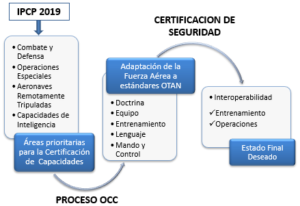
Strategic guidelines that potentiate the deterrence power of the Colombian Air Force, within the framework of cooperation with NATO.
It is evident that this partnership with NATO means support and accompaniment of the most powerful military organization in the world with our country and especially and particularly with its Forces, it means credibility in our capabilities, but fundamentally in our operational experience and in the development of our own Doctrine, it means training, exchange of experiences and lessons learned, standardization of procedures with the highest standards of performance. Finally, all these advantages help to build a deterrence (1:5).
Thus, being global partners of NATO implies a window of opportunities that should be incorporated into the organizational structure, taking as a reference NATO’s current strategic approach (See Table 2), which is focused on the modernization of defense capabilities, in which the main tasks of the organization are established as: collective defense, crisis management and cooperative security.
In this same sense, according to the Global Risks 2020 report, published by the World Economic Forum, it determines a series of emerging risks where Geopolitical Instability stands out with the following statement: “National politics in many countries have shown intense division and “backlashes”, together with increasingly frenetic international relations. These volatilities are likely to persist, challenging cooperation as a key priority,” also highlights as a risk the technology governance deficit, as a potential erosion of social discourse and threat to economic stability, implying the need for updated technology governance at all levels.
In terms of global risk perspectives, 78% of the world experts contributing to the preparation of this report agree on the increase in economic confrontations, internal political polarization, destruction of natural ecosystems and cyber-attacks, among the most significant.
Considering the above, it is evident that the most prominent current global threats coincide with the threats faced by the Colombian state, which have been duly described in Chapter 1 of the Defense and Security Policy PDS – For Legality, Entrepreneurship and Equity (2019). In this context, the World Economic Forum highlights cooperation as a key priority, which reinforces the relevance and importance of implementing the commitments established with NATO to strengthen the capabilities of the MMF and effectively face emerging threats.
In this same sense, the proposed guidelines are consistent with the Strategic Plan of the Defense and Security Sector (PES) 2018-2022, in reference to Objective No. 1, for being the one that potentially contributes to deterrence: guaranteeing the defense of the sovereignty, independence and integrity of the national territory, since it includes International Cooperation as a mission area; with respect to the National Development Plan Pact I they are related to Objective No. 8: Diplomacy for Defense and National Security and with respect to the Defense and Security Policy (2019), coincides the same Objective No 1 of the PES which also refers to diplomacy for defense and security, border security strategy, international and peace missions, strengthen cooperation and export capabilities, and the fight against transnational crime.
Finally, an analysis of the DOMPI model vs. the SWOT matrix of the Colombian Air Force in the framework of the agreement with NATO is elaborated, based on the sources consulted and the contribution of experts, where general strategic guidelines can be identified:
Table 5
General strategic guidelines through the DOMPI model vs. the FAC’s SWOT matrix within the framework of the NATO agreement.
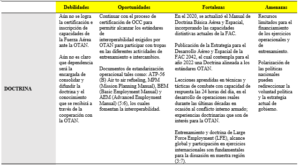
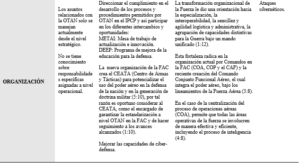
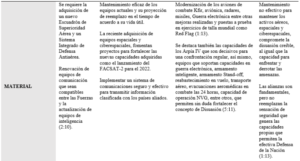
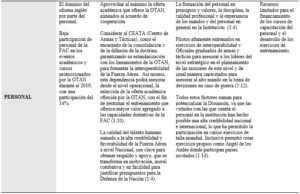
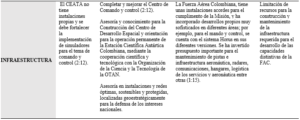
In this sense, the first proposed guideline, related to Doctrine and Organization, is to designate responsibilities at the operational level; since currently NATO-related issues at the Colombian Air Force level are handled exclusively at the strategic level through the Office of International Affairs with the coordination of Strategic Planning under the direction of COFAC (1: 9), for this reason it is proposed that the Weapons and Tactics Center be the unit at the operational level in charge of consolidating and disseminating the knowledge and doctrine resulting from the agreement with NATO, due to its mission: “To establish, create and coordinate the generation of operational capabilities in doctrine, techniques, tactics and effective procedures, in order to enhance the use of air power in the defense of the nation and train weapons and tactics officers with the highest standards of strategic leadership in the Air Force”; likewise, because this unit belongs to the Air Operations Command, which has the missional responsibility of the FAC, as shown in the following organizational chart:
Figure 7
COA Organizational Chart
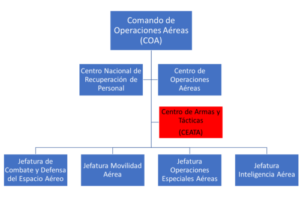
Thus, with this designation, the projects underway with NATO would be promoted, involving the Operational Level for the implementation of the agreement, once the Security Agreement is signed.
The Second Guideline focuses on Human Resources, where it is imperative the preparation of personnel to achieve the Interoperability of the FAC under NATO standards; for this reason, it is necessary to continue with the management and participation in international exercises and through the Aeronautical Education Office implement mechanisms to increase the English language level of the personnel of the Institution. A greater participation of FAC personnel in the Educational Offer offered by NATO must also be managed, since during 2019 the participation was 14% in the programmed courses and academic events.
The Third Guideline is to maintain and demonstrate the FAC’s Multipurpose Air Power, strengthening deterrence and diplomacy through global reach, which will be strengthened as a NATO Global Partner. Since 2008, the presence of the FAC in the world has been remarkable and significant and has not been limited to training or operational exercises mentioned in this article, also highlighting the missions in International Humanitarian Aid that reinforce the Polyvalence of the Institution:
Figure 8
Global presence of the FAC in the world, through humanitarian aid.
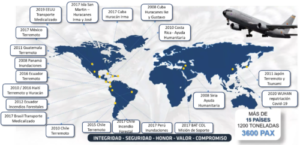
The fourth guideline is to manage the updating of air assets, prioritizing the acquisition of an integrated air defense system, comprising an air superiority squadron, an airborne warning and control aircraft and an air defense missile system, in order to maintain the balance of forces between Colombia and its potential regional threats.
Conclusions
It is worth noting the recent organizational and doctrinal changes of the Colombian Air Force, as a result of the transformation process implemented since 2018, motivated by the need to adapt to the global context, which involves international strategic alliances. Thus, its organizational structure, mission, vision, institutional motto, principles and values, among others, were recently updated. Likewise, the review of the strategic platform and the analysis of potential emerging threats, both internal and external, led to the definition of 20 distinctive capabilities that were enunciated in this article and that promote the dominance of air, space and cyberspace; which foster a credible, real and sustainable deterrence; projecting the institution as a polyvalent, interoperable force, with global reach and hemispheric leadership.
In the framework of the present research, it was necessary to review the characteristics and current status of the agreement with NATO, which was approved on May 18, 2017 by the NATO Council and which is characterized as “a functional, flexible and mutually reinforcing alliance that recognizes and builds on NATO’s strategic concept and Colombia’s national interests” (ICPC, 2019, p. 3). It was evidenced that since that date significant progress has been obtained such as the endorsement of the ICPC in 2019, which allows defining the principles, challenges and commitments shared with NATO. However, the implementation of the agreement is still in process and significant progress cannot be made until the Security Certification is granted by NATO, expected for this year.
Regarding the challenges and achievements expected by the Colombian Air Force in the framework of the cooperation with NATO, the organizational transformation of the Force gave it an orientation towards specialization, interoperability, simplicity and logistic and administrative agility, grouping the distinctive capabilities under a unified command; highlighting also in its strategic projection, the alignment of standards with NATO by 2022 and in the long term consolidate a multi-domain, interoperable and adaptable doctrine. In this context, the institution seeks to increase operational capabilities by homologating the structure with NATO (FAC, 2020), where it is currently advancing the certification process of distinctive capabilities in the areas of Combat and Defense, Special Operations, Remotely Manned Aircraft and Intelligence Capabilities, through the program: Operational Capability Concept Evaluation & Feedback Programme (OCC E&F) of NATO, which aims to improve the levels of interoperability and operational capabilities of the institution, to improve the operational relationship between the alliance and partners contributing to NATO-led operations.
Finally, knowing the current information, the potential opportunities and the scopes around the agreement with NATO, where Colombia is officially “Partnership Across the Globe”, four strategic guidelines are proposed that potentiate the deterrence power of the Colombian Air Force through the agreement:
- Regarding Doctrine and Organization, it is time to involve the institution at other levels in matters related to NATO and designate responsibilities at the operational level where it is proposed that the Center for Weapons and Tactics (CEATA), be the unit at the operational level in charge of consolidating and disseminating the knowledge and doctrine resulting from the agreement with NATO, this on account of its mission and its membership in COA.
- The Second Guideline focuses on Human Resources, where it is imperative the preparation of personnel to achieve the Interoperability of the FAC under NATO standards.
- The Third Guideline is to maintain and demonstrate the FAC’s Multipurpose Air Power, strengthening deterrence and diplomacy through global reach, which will be strengthened as a NATO Global Partner.
- The fourth guideline is to manage the updating of air assets, prioritizing the acquisition of an integrated air defense system, comprising an air superiority squadron, an airborne warning and control aircraft and an air defense missile system, in order to maintain the balance of forces between Colombia and its potential regional threats.
Thus, the distinctive capabilities of the FAC contribute to the level of national deterrence, an element that will be enhanced through the agreement with NATO, since they will be internationally certified in quality and interoperability and will also be strengthened through education, training and the exchange of lessons learned. Broad sense of the concept of deterrence reaffirmed by Barrero:
Deterrence Strategy is measurable also in other elements proper to air doctrine, such as the control of Air Space and Air Superiority that an Air Force is capable of sustaining through the means and technology it possesses, either in its own territory or in a Theater of War (2020, p. 180).
References
Álvarez, C., Rosanía, N., Sánchez, D., & Jiménez, G. (2017). Security and Defense: Concepts in Constant Transformation. In C. Álvarez, Scenarios and Challenges of Multidimensional Security in Colombia (pp. 29-83). Bogotá, D.C., Colombia: ESDEG-SIIA.
Barrero, D., Baquero, F., Conde, J, & Gaitán, A. (2020). The Integral Air Power of the Nation State in the 21st Century. Bogotá, D.C., Colombia: Planeta.
Barrero, D. (2017). La Estrategia de la Disuasión: Una variable independiente y potencializadora frente al Poder Aéreo Integral del Estado Nación en el siglo XXI. Escuela Superior de Guerra.
FAC. (2020). IV Air Force Antarctic Campaign in its final stretch. FAC. https://www.fac.mil.co/iv-campaña-antártica-de-la-fuerza-aérea-en-su-recta-final
FAC. (2020). Air Force Organizational Chart, current organization. https://www.fac.mil.co/transparencia-y-acceso-informacion-publica/3-estructura-organica-y-talento-humano/organigrama-fuerza-aerea.
FAC. (2020). Basic Air, Space and Cyberspace Doctrine Manual. Strategy for the Air and Space Development of the Colombian Air Force 2042. Restructuring Process.
Gomez, R. (2020). Agreement to formalize Colombia as a NATO global partner. Report 01 July 2020. Military Defense Attaché in Belgium and NATO.
Group, I. partnership with M. & M. and Z. I. (2020). 2020 economic forum report. https://www.marsh.com/mx/insights/research/global-risks-report-2020.html
Is the concept of deterrence valid in the 21st century? Foreign Policy, 20(109), 83-93. http://basesbiblioteca.uexternado.edu.co:2145/stable/20645880
Lara Silva, A., & Jiménez Reina, J. (Eds.). (2019). Situational analysis of the individual partnership and cooperation program between Colombia and NATO (War College ed.).
Mayumi Okudi, B. (2005). Qualitative research methods: triangulation. Colombian journal of psychiatry, 34(1), 118-124.
Melgarejo, C. (2020, February 28). Plane bringing Colombians from Wuhan arrives in Bogota. El Tiempo. https://www.eltiempo.com/politica/gobierno/operativo-para-traer-a-colombianos-en-wuhan-siga-en-vivo-como-avanza-la-mision-465016.
Ministry of National Defense (2019a). Strategic Plan for the Defense and Security Sector: Strategic Planning Guide (2018-2022). 88. https://www.mindefensa.gov.co/irj/go/km/docs/Mindefensa/Documentos/descargas/Sobre_el_Ministerio/Planeacion/Politicas/Guia_Planeamiento_Estrategico_2018-2022.pdf
Ministry of National Defense. (2019b). Defense and Security Policy – PDS – For Legality, Entrepreneurship and Equity. 1-85.
NATO, (July 11, 2018). Brussels Summit Declaration.
NATO, (May 28, 2019). ICPC, Individual Partnership and Cooperation Program between NATO and the Republic of Colombia. Unclassified.
NATO, (2020). Major Milestones. Member States and Characteristics. Basic Aspects. https://www.nato.int/nato-welcome/index_es.html
Palazón, M. Y. (2018). The strategic implications of space deterrence in the framework of Sino-American relations. Revista De Estudios En Seguridad Internacional, 4(1), 177-195. http://dx.doi.org/10.18847/1.7.11
Ramirez, M. S. (2008). Triple-entry table for building open learning object tools. Retrieved from http://catedra. ruv. itesm. mx/bitstream/987654321/367/1/Cuadro% 20concentrado% 20para% 20OAs, 20, 2810-03.
Royal Spanish Academy (2020). Dictionary of the Spanish language. Real Academia Española. https://dle.rae.es
Salamanca, A., & Martín-Crespo, C. (2007). Sampling in qualitative research. Nure investigación, 27(07), 1-4.
Sodupe, K. (1991). Deterrence theory: an analysis of the weaknesses of the statocentric paradigm. Revista CIDOB D’Afers Internacionals, , 53-11.
Wiggins, R. R. (2019). Deterrence. Salem Press.
[1] The research article is the result of the project called “Challenges and new scenarios of multidimensional security in the national, regional and hemispheric context in the decade 2015- 2025” of the “Center of Gravity” Group categorized in A1 by Minciencias and attached to the Escuela Superior de Guerra “General Rafael Reyes Prieto”.
[2] Officer of the Colombian Air Force. Aeronautical Administrator, Escuela Militar de Aviación “Marco Fidel Suárez”. Mail: Paula.carrasquilla@fac.mil.co ORCID ID: 0000-0001-6318-276X.
[3] Barrero, D. (2017) highlights this position in the Colombian Air Force Air and Space basic doctrine manual “deterrence seeks to convince the enemy that his “losses will be greater than the gains obtained in the achievement of his objective” (JEA J., 2016, p. 54).
[4] Melgarejo, C. (2020). Plane bringing Colombians from Wuhan arrives in Bogota. Aircraft B-767 FAC 1202, in a flight that circled the world picked up compatriots and foreigners from the city where COVI-19 emerged. FAC (2020). IV Air Force Antarctic Campaign: C-130 Hercules transported from Punta Arenas to King George Island 10 scientific researchers of the Colombian Air Force, to start different meteorology projects, identification of operational hazards, satellite communications and development studies of space analog missions.
[5] (1:14) The formation in principles and values, discipline, professional preparation, motivation and combat morale, training, operational experience, among many others, are elements that add up to potentiate Deterrence. This translates into the fear of facing a modern and high performance Force, at the level of the best in the world.
[6] Held on July 11-12, 2018 at the new NATO Headquarters in Brussels, with Allied Heads of State and Government and chaired by NATO Secretary General Jens Stoltenberg. Held at a crucial time for the security of the North Atlantic Alliance and an important opportunity to chart NATO’s path for the coming years.
Disclaimer: The views and opinions expressed in this article are those of the author. They do not necessarily reflect the official policy or position of any agency of the U.S. government, Diálogo magazine, or its members. This Academia article was machine-translated.

